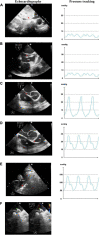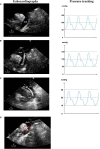Echocardiography-Guided Percutaneous Patent Ductus Arteriosus Closure: 1-Year Single Center Experience in Indonesia
- PMID: 35677684
- PMCID: PMC9167953
- DOI: 10.3389/fcvm.2022.885140
Echocardiography-Guided Percutaneous Patent Ductus Arteriosus Closure: 1-Year Single Center Experience in Indonesia
Abstract
Introduction: Since the first successful percutaneous closure under transesophageal echocardiographic (TEE) guidance, many centers explored transcatheter procedures without fluoroscopy. This single-center study is aimed to show the feasibility and safety of percutaneous patent ductus arteriosus (PDA) closure under echocardiography-only guidance during our 1-year experience.
Methods: Patients with PDA were recruited for percutaneous PDA closure guided by either fluoroscopy or echocardiography-only in National Cardiovascular Center Harapan Kita (ClinicalTrials.gov Identifier: NCT05321849, clinicaltrials.gov/ct2/show/NCT05321849). Patients were evaluated clinically and radiologically using transthoracic echocardiography (TTE) at 6, 24, and 48 h after the procedure. The primary endpoint was the procedural success. Secondary endpoints were the procedural time and the rate of adverse events.
Results: A total of 60 patients underwent transcatheter PDA closure, 30 patients with fluoroscopy and 30 patients with echocardiography guidance. All patients had successful PDA closure. There were only residual shunts, which were disappeared after follow-up in both groups, but one patient with a fluoroscopy-guided procedure had moderate tricuspid regurgitation with suspected thrombus in the tricuspid valve. The procedural time was not significantly different between the fluoroscopy and echocardiography groups.
Keywords: congenital heart disease; echocardiography; fluoroscopy; patent ductus arteriosus; percutaneous.
Copyright © 2022 Siagian, Prakoso, Putra, Kurniawati, Lelya, Sembiring, Atmosudigdo, Roebiono, Rahajoe, Harimurti, Mendel, Christianto, Setiawan and Lilyasari.
Conflict of interest statement
The authors declare that the research was conducted in the absence of any commercial or financial relationships that could be construed as a potential conflict of interest.
Figures



Similar articles
-
Transesophageal echocardiography-guided percutaneous patent ductus arteriosus closure without fluoroscopy.J Cardiothorac Surg. 2023 Apr 15;18(1):142. doi: 10.1186/s13019-023-02248-8. J Cardiothorac Surg. 2023. PMID: 37060014 Free PMC article.
-
Transcatheter Closure of Patent Ductus Arteriosus under Echocardiography Guidance: A Randomized Controlled Noninferiority Trial.J Interv Cardiol. 2020 Oct 3;2020:4357017. doi: 10.1155/2020/4357017. eCollection 2020. J Interv Cardiol. 2020. PMID: 33093816 Free PMC article. Clinical Trial.
-
Transcatheter Closure of a Paravalvular Leak Guided by Transesophageal Echocardiography and Three-Dimensional Printing.Front Cardiovasc Med. 2022 May 20;9:750896. doi: 10.3389/fcvm.2022.750896. eCollection 2022. Front Cardiovasc Med. 2022. PMID: 35669478 Free PMC article.
-
Echocardiographic guidance for transcatheter patent ductus arteriosus closure in extremely low birth weight infants.Congenit Heart Dis. 2019 Jan;14(1):74-78. doi: 10.1111/chd.12725. Congenit Heart Dis. 2019. PMID: 30811801 Review.
-
Transcatheter closure of patent ductus arteriosus: past, present and future.Arch Cardiovasc Dis. 2014 Feb;107(2):122-32. doi: 10.1016/j.acvd.2014.01.008. Epub 2014 Feb 20. Arch Cardiovasc Dis. 2014. PMID: 24560920 Review.
Cited by
-
Zero to minimal fluoroscopy for cardiac electronic device implantation: A systematic review and meta-analysis.J Arrhythm. 2023 Nov 15;40(1):38-46. doi: 10.1002/joa3.12949. eCollection 2024 Feb. J Arrhythm. 2023. PMID: 38333407 Free PMC article.
-
Transoesophageal echocardiography-guided balloon-assisted percutaneous closure of a large secundum atrial septal defect in a pregnant woman: a case report.Eur Heart J Case Rep. 2024 Jan 6;8(1):ytae014. doi: 10.1093/ehjcr/ytae014. eCollection 2024 Jan. Eur Heart J Case Rep. 2024. PMID: 38274706 Free PMC article.
-
Transesophageal echocardiography-guided percutaneous patent ductus arteriosus closure without fluoroscopy.J Cardiothorac Surg. 2023 Apr 15;18(1):142. doi: 10.1186/s13019-023-02248-8. J Cardiothorac Surg. 2023. PMID: 37060014 Free PMC article.
-
Zero contrast technique in doubly committed subarterial ventricular septal defect closure in patient with body weight less than 10 kg: a case report.Front Cardiovasc Med. 2025 Jul 2;12:1564232. doi: 10.3389/fcvm.2025.1564232. eCollection 2025. Front Cardiovasc Med. 2025. PMID: 40672379 Free PMC article.
-
Echocardiography-guided percutaneous closure of oval-shaped secundum atrial septal defects.BMC Cardiovasc Disord. 2024 Oct 3;24(1):534. doi: 10.1186/s12872-024-04165-7. BMC Cardiovasc Disord. 2024. PMID: 39363250 Free PMC article.
References
Associated data
LinkOut - more resources
Full Text Sources
Medical

